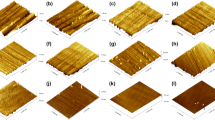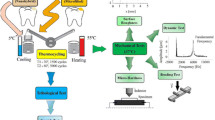Abstract
Tribological characterization of dental restorative materials is very hard because it is difficult to reproduce the actual test conditions which occur in the mouth. Despite the wide variety of wear test equipment, there are no wear test standards. The guide provided by the International Organization for Standardization (ISO), entitled “ Dental materials—guidance on testing of wear—part 2: Wear by two- and/or three body contact, Technical Specification 14569-2 number 2001 focuses only on a technical description of the procedures. This standard doesn’t evaluate or demonstrate any of the advantages or disadvantages of the existing tests or their procedures. This work is focused on the evaluation of the effect of abrasion solution. Three abrasive of the most common used were select. Test condition such as load and number of cycles were established, in order to attain specific wear rates similar to the ones in the mouth. From a soft organic abrasive to more severe abrasive several solutions were tested. Wear analyses was done using two distinct approaches; a classical and an energetic. A glass sphere against a flat direct restorative composite surface on a reciprocating sliding contact were selected for the evaluation, initial conditions were set based on previous studies which provided decisive information for the selection of adequate laboratorial parameters. It was found that the wear evolution of the composite and antagonist materials depends directly on the abrasive solution and test conditions used. It was necessary to fix a standard parameter to compare abrasive solutions, wear rate (mm3/cycle) of natural teeth. The use of each abrasive solution can be made depending on the purpose of the study, i.e., if it is comparative performance of a particular material or if you want to simulate more closely what goes into the mouth. If the purpose of the study is to compare performance of particular materials (more severe abrasive solution) or if we want to simulate more closely what happens in the mouth (mild abrasive solution). A morphological and wear mechanisms analysis were done using SEM, this allowed to compare qualitatively the effect of abrasive solution on the material pair.











Similar content being viewed by others
References
Antunes, Pedro Alexandre de Almeida do Vale (2012) “Physical-mechanical characterization of direct restorative dental materials”, Coimbra: [s.n.], PhD thesis, ISBN: 978-972-8954-24-6
Heintze SD (2006) How to qualify and validate wear simulation devices and methods. Dent Mater 22:712–734
Ramalho A, Vale Antunes P (2005) Reciprocating wear test of dental composites: effect on the antagonist. Wear 259:1005–1011
Lambrechts P, Braem M, Vuylsteke-Wauters M, Vanherle G (1989) Quantitative in vivo wear of human enamel. J Dent Res 68(12):1752–1754
Josephine F, Esquivel-Upshaw, William Rose F Jr, Allyson Barrett A, Erica Oliveira R, Mark Yang CK, Arthur Clark E, Kenneth Anusavice J (2012) Three years in vivo wear: core-ceramic, veneers, and enamel antagonists. Dent Mater 28:615–621
Krämer N, Kunzelmann K-H, Taschner M, Mehl A, Garcia-Godoy F, Frankenberger R (2006) Antagonist enamel wears more than ceramic inlays. J Dent Res 85(12):1097–1100
Etman MK, Mark Woolford, Stephen Dunne (2008) Quantitative measurement of tooth and ceramic wear. in vivo study”. Int J Prosthodont 21:245–252
Sajewicz E (2006) On evaluation of wear resistance of tooth enamel and dental materials. Wear 260:1256–1261
Rekov ED, van Thompson P, Jahanmir S, Nagarajan R (1997) Wear in the unique environment of the mouth. Second joint American-Eastern European Conference on new materials and technologies in tribology, abstract of papers. Infotribo, Gomel, p 45
Söderholm KJM, Sarrett D, Abe Y, Yang MCK, Labella R, Yildiz E, Willems G (2001) Clinical wear performance of eight experimental dental composite over three year determined by two measuring methods. Eur J Oral 109:273–281
ISO ((2001)) Dental material, guidance on testing of wear. Part 2. Wear by two-and/or three-body contact. Technical specification no. 14569-2
Lambrechts P, Debels E, Landuyt K, Peumans M, Meerbeek B (2006) How to simulate wear? Overview of existing methods. Dent Mater 22:693–701
Antunes P, Ramalho A (2003) Study of abrasive resistance of composites for dental restoration by ball-cratering. Wear 255:990–998
Kelly DA, Hutchings M (2001) A new method for measurement of particle abrasivity. Wear 250(1–12):76–80
Heintze SD, Faouzib M, Roussonb V, Özcanc M (2012) Correlation of wear in vivo and six laboratory wear methods. Dent Mater 28:961–973
Heintze SD, Barkmeier WW, Latta MA, Rousson V (2011) Round robin test: wear of nine dental restorative materials in six different wear simulators—supplement to the round robin test of 2005. Dent Mater 27:e1–e9
de Gee AJ, Pallav P, Davidson CL (1986) Effect of abrasion medium on wear of stress bearing composites and amalgam in vitro. J Dent Res 65(5):654–658
Leinfelder KF, Suzuki S (1999) In vitro wear device for determining posterior composite wear. J Am Dent Assoc 130:1347–1353
Condon J, Ferracane J (1996) Evaluation of composite wear with a new multi-mode oral wear simulator. Dent Mater 12:218–226
Satou N, Khan AM, Satou K, Satou J, Shintani H, Wakasa K, Yamaki M (1992) In-vitro and in vivo wear profile of composite resins. J Oral Rehabil 19:31–37
Kakuta K, Ogura H (2008) Effects of abrasive and fiber components in medium on wear of composite resins. Den Mater J 27(5):716–722
Lawson NC, Cakir D, Beck P, Litaker MS, Burgess JO (2012) Characterization of third-body media particles and their effect on in vitro composite wear. Dent Mater 28:e118–e126
Heintze SD, Zappini G, Rousson V (2005) Wear of ten dental restorative materials in five wear simulators-Results of a round robin test. Dent Mater 21:304–317
Nihei T, Dabanoglu A, Teranaka T, Kurata S, Ohashi K, Kondo Y, Yoshino N, Hickel R, Kunzelmann K-H (2008) Three-body-wear resistance of the experimental composites containing filler treated with hydrophobic silane coupling agents”. Dent Mater 24:760–764
Vale Antunes P, Ramalho A (2009) Influence of pH values and aging time on the tribological behaviour of posterior restorative materials. Wear 267:718–725
Ramalho A, Antunes PV (2007) Reciprocating wear test of dental composites against human teeth and glass. Wear 263(7–12):1095–1104
ASTM G133-95 (2002) Standard test method for linearly reciprocating ball-on-flat sliding wear. Annual book of ASTM standards, vol 03.02. West Conshohocken, pp 558–565
Czichos H (1978) Tribology: a systems approach to the science and technology of friction, lubrication, and wear; 1 edn. Bundesanstalt fur Materialprufung (BAM) (Federal Institute for Testing Materials); Berlin–Dahlem and Technische Fachhochshule Berlin
Ramalho A, Miranda JC (2006) The relationship between wear and dissipated energy in sliding systems. Wear 260:361–367
Ramalho A (2010) A reliability model for friction and wear experimental data. Wear 269:213–223
Antunes PV, Ramalho A, Carrilho EVP (2014) Mechanical and wear behaviours of nano and microfilled polymeric composite: effect of filler fraction and size. Mater Des 61:50–60
Khruschov MM (1974) Principles of abrasive wear. Wear 28:69–88
Author information
Authors and Affiliations
Corresponding author
Additional information
Technical Editor: Estevam Barbosa Las Casas.
Rights and permissions
About this article
Cite this article
Antunes, P.V., Ramalho, A.L. Influence of abrasive solutions on direct restorative composites wear. J Braz. Soc. Mech. Sci. Eng. 40, 20 (2018). https://doi.org/10.1007/s40430-017-0942-2
Received:
Accepted:
Published:
DOI: https://doi.org/10.1007/s40430-017-0942-2




